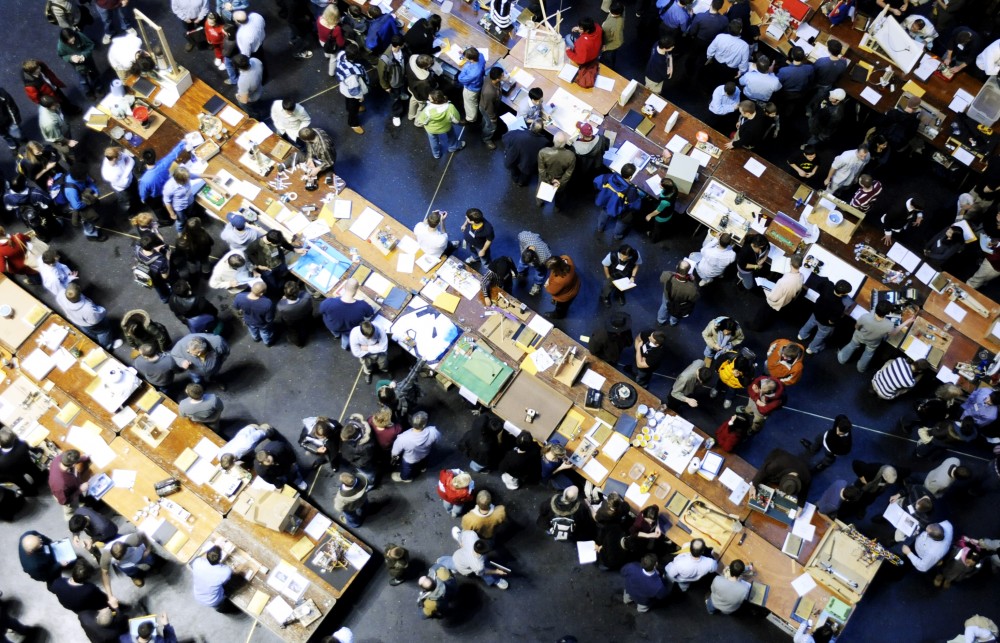Final exams donâÄôt usually warrant the attendance of kids, students and industrial professionals alike. Then again, they donâÄôt usually involve an automatic fish feeder, miniature factory crane and marshmallow roaster either. These are just a few of the more than 200 robotic creations by University of Minnesota students displayed Monday afternoon. McNamara Alumni Center teemed with onlookers, who watched as students demonstrated their creations and contended with the very real-life issue of broken or finicky parts. Students in mechanical engineering professor William DurfeeâÄôs course had been given a âÄúsparse kitâÄù of components, including a small computer and some motors, and tasked with building a robot that âÄúdid something interestingâÄù when the user pushed a button. Students could spend no more than $30 to customize their robots with other items. âÄúWe encourage them to do dumpster diving,âÄù Durfee said. Durfee, who has taught the course since its inception, said âÄúitâÄôs important for students to engage in an open-ended design project where there is no correct solution.âÄù âÄúTheyâÄôre so used to taking physics and math courses where you do the problem at the end of the bookâĦand then there is one right answer. âÄúEngineers operate completely differently âÄî there are many solutions to how your music player works, how your computer works, how your car works,âÄù he said. Though not a competition, the projects were judged by about 150 people, mostly professionals from local industries, Durfee said. This year, Lars Oddsson , director of research at the Sister Kenny Rehabilitation Institute , was a judge for the second time. As a professional engineer, he said the projects that appeal to him most repurpose items that were used for a completely different purpose before. Students take âÄújunk,âÄù he said, and find ways to use it creatively. They commonly used scrap wood and metal, and junior Thomas Wieselmann used the wheel off a toy truck in his automatic fish feeder. The device used an arm with a fish food bottle attached to one end, which swung over a âÄúfish bowlâÄù and sprinkled some food out of the container. Though he and his roommatesâÄô fish have all died âÄî not, he said, from lack of food âÄî the device could come in handy for others, like vacationers who leave their fish behind. He could program it to dispense food every 24 hours, he said. The project was a lot more hands-on, he said, than other things heâÄôd done for school. And when things didnâÄôt work right, âÄúthen you have to come up with plan B,âÄù he said. For example, his initial design didnâÄôt translate quite right from two dimensions to three, and he had to make some modifications. Learning about the design process students will use as professional engineers was a key part of the project, Durfee said. Though the projects had engineering appeal, professionals werenâÄôt the only people it attracted. Jay Kokate , a judge from Boston Scientific , had his daughter in tow. He said he wanted to make sure she sees women engineers. Mechanical engineering student Crystal Sparkman said her marshmallow roaster was âÄúa huge hit with the little kids.âÄù They knew what it was right away, she added. The roaster rotated a skewered marshmallow over a light bulb, intending to heat it. But the light bulb took too much battery power for it to stay on long enough to actually roast a marshmallow. She said with a different heating element, either a fire or a better light bulb, the machine could aid in sâÄômore-making. Durfee said he couldnâÄôt point to any single best project. âÄúI think a lot is in the eye of the beholder,âÄù he added. He added the project was a way for students to express their own interests. âÄúYou learn some things about students just by what they chose to make for their machine,âÄù he said. ItâÄôs like a visual resume, he added.











